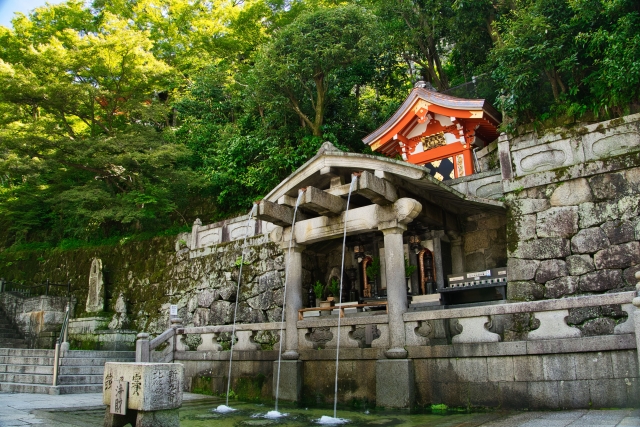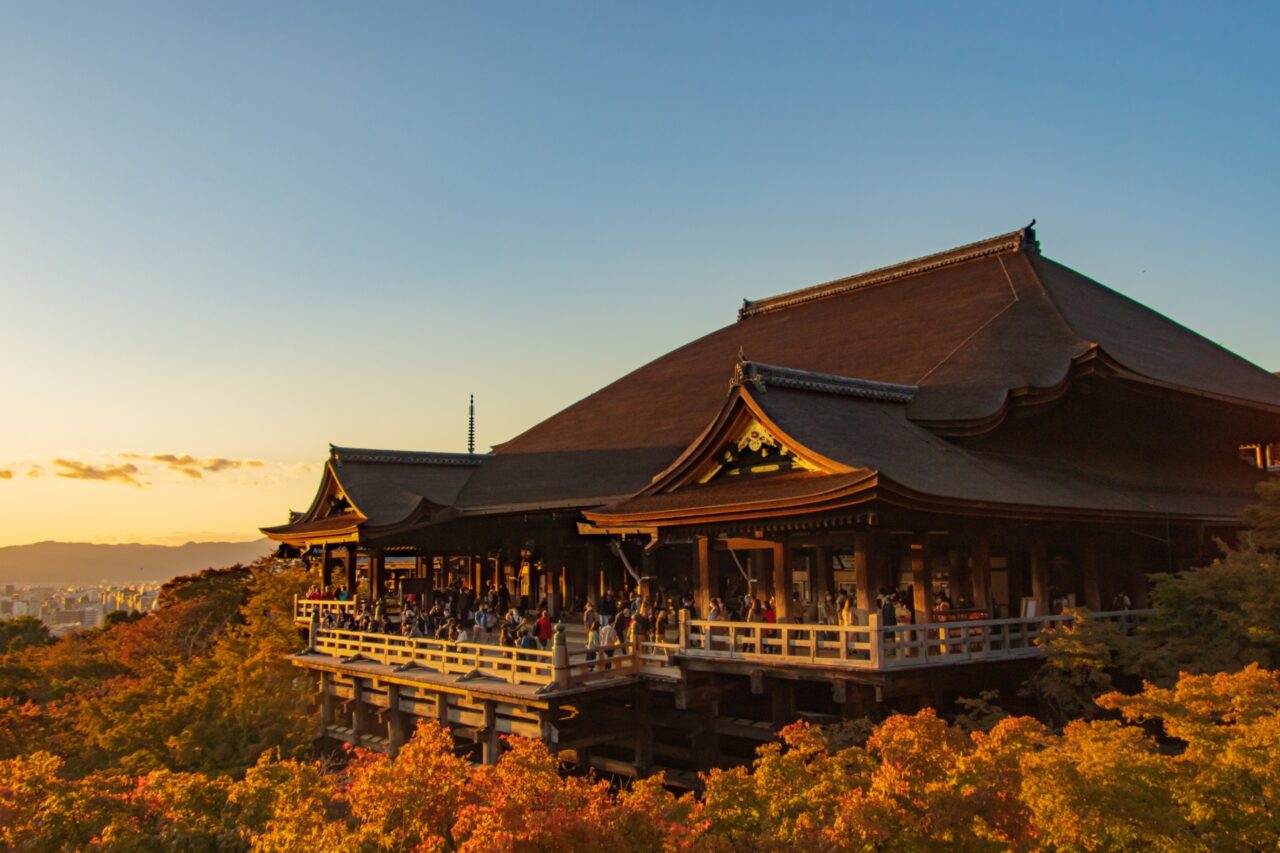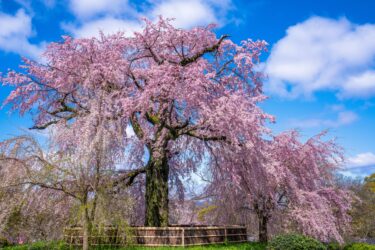Perched on the slopes of Mount Otowa in Kyoto’s Higashiyama district, Kiyomizu-dera Temple is one of Japan’s most celebrated temples. Renowned for its panoramic views, rich history, and stunning architecture, this UNESCO World Heritage Site draws millions of visitors annually. It’s on nearly every list of can’t-miss Kyoto spots, and it’s not hard to see why.
A Glimpse into the History

Kiyomizu-dera, literally, the “Pure Water Temple,” was founded in 778 AD by the monk Enchin. The temple is dedicated to Kannon, the goddess of mercy, a central figure in Japanese Buddhism. The name of the temple itself comes from the Otowa Waterfall that still flows on the temple grounds, whose pure waters have been revered for centuries.
Though the original structure was destroyed multiple times by fire, the temple we see today was rebuilt in 1633 under the patronage of the Tokugawa shogunate (1603-1868). In 1994, Kiyomizu-dera was designated a UNESCO World Heritage Site as part of the Historic Monuments of Ancient Kyoto, securing its place as a must-visit destination for both history enthusiasts and casual travelers.
Architectural Marvels
The Main Hall and Its Famous Stage

The most iconic feature of Kiyomizu-dera is its Hondo (Main Hall), known for its massive wooden stage that extends 13 meters (43 feet) above the hillside. Remarkably built entirely without nails, the structure is a testament to the ingenuity of traditional Japanese carpentry.
From the stage, visitors are treated to a panoramic view of Kyoto, framed by cherry blossoms in spring and vibrant autumn foliage in fall. The phrase “jumping off the stage at Kiyomizu” has even become a Japanese idiom meaning to take a leap of faith, although it has a dark history: in the Edo period (1603-1868), it was believed that surviving a jump from the stage would grant one’s wish—a practice that, thankfully, was banned in the late 19th century.
Jishu Shrine: A Place for Lovers


Tucked away behind the main hall is Jishu Shrine, dedicated to Okuninushi, a Japanese deity of love and matchmaking. The shrine features two “Love Stones” placed 18 meters apart. Tradition says that if you can walk from one stone to the other with your eyes closed, you’ll find true love.
This shrine is a popular spot for couples and visitors looking for romantic fortunes, and the playful element of walking blind between the stones makes this a fun visit while you’re on the temple grounds.
Three-Story Pagoda

Another highlight is the incredible 31-meter tall, three-story pagoda that greets visitors near the temple entrance–the tallest such pagoda in Japan. The pagoda’s bright vermillion-orange can even be seen from some parts of downtown Kyoto, across the Kamo River, as a bright orange spike rising from the hillside.
Otowa Waterfall

When you’ve walked across the temple stage, and along a path on the mountainside that’ll treat you to some incredible views–both of the city of Kyoto, and looking back at the Main Hall rising from the maple trees–you’ll come down to the base of the temple, and Otowa Waterfall, divided into three streams. Visitors can drink from one of the streams using long-handled ladles. The water is said to grant longevity, the wishes of drinkers.
Seasonal Beauty at Kiyomizu-dera Temple
Kiyomizu-dera is a particularly scenic temple, and its shifting seasonal landscape draws crowds throughout the year.
Spring

In spring, the temple grounds are spotted with blooming cherry trees that create a pretty pink and white backdrop. The sight of the blossoms framing the wooden stage is a favorite among photographers and nature lovers.
Summer
During the summer months, lush greenery envelops the temple, providing a refreshing contrast to the heat of Kyoto. The cool shade of the trees and the sound of the Otowa Waterfall make it a serene retreat, but you’ll still want to visit with a fan and some water.

Autumn

Autumn is arguably the most popular time to visit, as the temple is surrounded by fiery red, orange, and yellow leaves. The view from the stage is particularly spectacular, offering a sea of vibrant colors stretching across the city. Like many other temples in Kyoto, Kiyomizu-dera also offers a special nighttime opening during this season, with lights to illuminate the colorful leaves.
Winter
In winter, occasional snowfall adds a peaceful and almost mystical atmosphere to the temple grounds. The white snow against the dark wooden structures makes the temple look straight out of a postcard.

How to Get to Kiyomizu-dera Temple
Kiyomizu-dera is conveniently located in Kyoto’s Higashiyama district, making it easily accessible from various parts of the city. Unlike some other temples, though, the surrounding streets, filled with historical buildings and plenty of touristy but fun shopping, are a part of the experience of visiting the temple today, so you won’t be starting your journey right outside the temple gates, but instead at the base of one of several famous hillside streets.
From Kyoto Station
By Bus: Take Kyoto City Bus No. 100 or No. 206 and get off at Gojo-zaka or Kiyomizu-michi. From there, it’s a 10-minute uphill walk to the temple.
By Taxi: A taxi ride from Kyoto Station takes around 15 minutes and costs approximately 1,500–2,000 yen.
From Gion
No need to take transit! From Gion, you can simply enjoy the scenic walk through the historic streets of Higashiyama. The walk should take about 20–25 minutes.
Tips for Visiting Kiyomizu-dera Temple

Because this is one of Kyoto’s most popular temples, your best shot at getting the temple to yourself, if that’s what you prefer, is to visit early in the morning (Kiyomizu-dera has unusually long opening hours). The temple is especially busy during cherry blossom and autumn foliage seasons.
Entry Fee and Hours
Admission: 400 yen for adults, 200 yen for children. (*As of December 2024)
Hours: 6:00 a.m. to 6:00 p.m. (with extended hours during special evening illuminations).
You’ll also want to wear comfortable shoes: since this temple is located on a hillside, you’ll have to make your way up an uphill stone-paved path to get there.
If you’re planning on taking photos at the temple, be aware that photography is allowed, but remember to be respectful of other visitors and avoid using flash inside the temple.
Nearby Attractions
The Higashiyama area is quite dense with beautiful locations to visit, all of them within a reasonable walking distance from one another, so while you’re in the area, you may want to consider checking them out as well.
Sannenzaka and Ninenzaka

These historic stone-paved streets are lined with traditional shops, cafes, and souvenir stores. It’s a great place to try local Kyoto treats like yatsuhashi (cinnamon rice crackers, or a soft version made with mochi and sweet bean paste) or pick up some traditional crafts.
Kodai-ji Temple

A short walk from Kiyomizu-dera, Kodai-ji is a Zen temple known for its beautiful gardens and seasonal illuminations.
Yasaka Pagoda (Hokan-ji Temple)

This five-story pagoda is one of Kyoto’s most photographed landmarks. The narrow streets leading to the pagoda provide a perfect backdrop for a classic Kyoto photo.
Kiyomizu-dera Temple is a true gem of Kyoto, offering a perfect blend of history, architecture, and natural beauty. This iconic temple should be at the top of your Kyoto itinerary, but it’s easy to combine with an exploration of the surrounding Higashiyama district, and even Kyoto’s nearby downtown area. So, take the leap—though not off the stage!—and see what Kiyomizu-dera Temple is all about.








